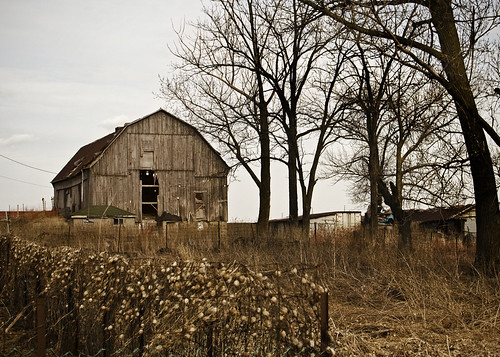
It's amazing what you can find in your own neighbourhood.
Here at the northern edge of Toronto's suburbs, we're pretty much on the frontier - the frontier separating southern Ontario's disused farmland from rampant housing developments and suburban sprawl. Just a few minutes' walk to the north is a roadway, recently expanded to four lanes from the two that were there when we moved in, twelve years ago. On the other side - farmland, some of it still in use. But few, if any, of the farmhouses standing in the fields are inhabited. One by one, boards are appearing in windows, outbuildings are being dismantled, and the last remnants of picturesque rail fences are falling into disrepair.
The whole area, like much of this part of Canada, was farmland, supporting mainly a mix of dairy cattle and feed corn, with crop corn and other vegetables scattered here and there. All over are dotted barns with their characteristic double-angled roofs, a style I've always thought of as somehow Dutch in nature - although I have no good reason for thinking this.

Most of these are on the verge of collapse, too, waiting for the day when their surrounding fields are sold to developers and the bulldozers come.
There are few other reminders left of the stoic people who first came here to farm. Maple itself, although a fairly old town by Ontario standards, has essentially no historic buildings to speak of. Memorials to the settlers and pioneers are thin on the ground, although I tripped across one recently, tucked away among some trees adjacent to an industrial property or two, looking for all the world like a war memorial. It's labeled "Primitive Methodist Church", and "Pioneer Cemetery", although the mid-1800's seems a bit late to be talking about "pioneers" in these parts. Nevertheless, I'm glad it's there, as a little reminder of things past, as things future grow up all around it.

Technical details
Nikon D5000
Top photo: AF-S DX Nikkor 55-300mm f/4.5-5.6G ED VR
Bottom two photos: AF-S DX Nikkor 35mm f/1.8G, Tiffen circular polarizer
8 comments:
Again,superb pics, Mr,F!
Technical.....????????????
I forgot to list the details of aperture, exposure time, ISO and focal length (for the 55-300mm shot). I'll get those updated for ya right away, John. ;)
Cheers! ???
Excellent Ricardipus! I traveled a few of those roads N of Toronto (the road to Meaford and Owen Sound comes to mind), some through Dufferin County (named after some Welsh man - Dyffryn in Welsh is Valley, but you knew that...). Never saw any other Welsh names though. I found a lot of those places to be similar in architecture, but I thought they were Scandinavian. In Sweden in particular, most barns were painted red, using earth materials, but the 'rich' painted them yellow as they could afford paint.
Ah yes... Dufferin Street runs nearby that barn (and all the way downtown too, as it turns out). I actually didn't know the Welsh connection for that word, so thanks for that!
There is a Madoc, Ontario, a bit farther east from here - that's the only one that jumps to mind, but there are probably others. There is a "Swansea" neighbourhood in Toronto though.
Most of the barn roofs around here are either red, or plain corrugated sheet metal with varying amounts of rust.
Ah, Madoc. He was the Prince from N Wales who sailed in 1170 and discovered America. Some of his descendants are classified as American Indians, and still use some Welsh words. It is claimed a Welsh missionary in the 1800s was able to communicate with them. And the Indians had blue eyes. So must have been true....
Great Photos!
With your choice of scenery, you'd have a "field day" in Nebraska!
Steve
Steve - thanks! If I had any excuse to visit Nebraska (hint, hint... ;)).
Post a Comment